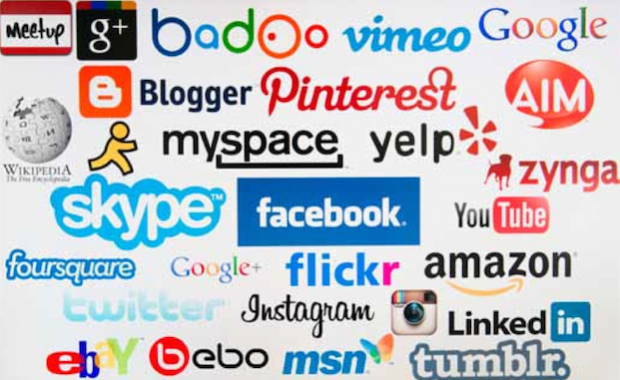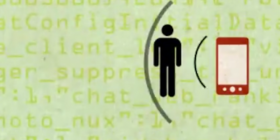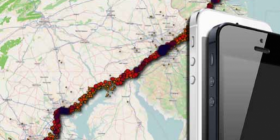Our comprehensive report on surveillance in Canada is available. Download it here.
Trend 9 – Watching by the People: From Them to Us

When we think of surveillance, what typically comes to mind are the activities of organizations such as corporations or the police. These are enormously important players in the operation of surveillance, but there is an entire realm of watching conducted by individuals that is not coordinated by organizations. This watching undertaken by everyday citizens has expanded in recent years, often with the aid of new information technologies, and it represents yet another broad trend in the contemporary dynamics of surveillance in Canada.
People watch one another, and they have always done so. We watch because it gives us strategic power over others, because people are inherently interesting, and because, as can be seen in the broad sweep of human history, watching others provides an evolutionary advantage.1 We come to know the world around us and our place in it by interacting with other people. Watching and being watched are also fundamental parts of how we define who we are. We act out roles—child, sibling, parent, employee, friend, spouse, lover—and adopt characteristics depending on how our performances are received by others. We shape our identities based on how other people see us and react to our behaviour.2
So people have always conducted routine forms of day-to-day surveillance of other people. In recent years, however, such scrutiny appears to have expanded. We now watch in ways that only a short time ago would have been impossible or taboo. This change can be explained, in part, by the emergence of new technologies that make it easier for individual citizens to become watchers. It is also a sign of a growing surveillance culture, where watching has become a routine and unremarkable part of social life.
The surveillance conducted by organizations often (but not only) involves the more powerful watching the less powerful. So, for example, the police watch criminals, social workers scrutinize people on social assistance, and employers monitor workers. What makes the surveillance conducted by everyday citizens particularly interesting is that it can involve people from the less powerful echelons of society monitoring people from more powerful levels. So, for example, individuals now use camera-equipped smartphones to record police behaviour.3 Global media also shine an often intense light on the foibles and indiscretions of celebrities and political figures.
This type of surveillance can involve some of the most intimate realms of our lives. Parents, for example, use new commercially available smart- phone monitoring applications and even home drug tests to expand upon their traditional responsibility to watch their children. They also set up “nanny cams” in household objects such as smoke detectors or teddy bears to secretly monitor spouses, children, and caregivers. Canadians involved in the substantial world of online dating have been encouraged to run formal background checks on potential romantic partners. Should the romance go sour, they might hire private detectives who specialize in exposing unfaithful spouses.
Perhaps the most interesting and fluid area of citizen-initiated monitoring can be found in the realm of online social media. Given the ever increasing significance of such media, we focus on them here as an extended example of how citizens are increasingly caught up in the dynamics of surveillance, not just as the targets of observation but also as watchers themselves.
Individual Surveillance for Connection and Convenience
Given that surveillance can have a negative impact on our political, social, and economic relationships, it may seem strange to suggest that surveillance can also be fun. But there is an unmistakable playfulness in watching and being watched by others, as has become particularly apparent on social net- working sites. We post photos and comments on Facebook and Twitter and look at what friends, family members, and neighbours have posted about themselves because it gives us a window into the lives of others. By making supportive, funny, or crude comments or by tagging photos and “liking” products and videos, we also shape how others see us. While these services can be abused—for example, in cases of stalking and harassment—they also help us to strengthen our sense of connectedness to the people in our community.
Canadians have embraced social networking, and many of us use social media platforms as a matter of course. For example, as of 2011, some 15.4 million Canadians were on Facebook, and Canada had more users per capita than any other country in the world.4 In a recent survey, 79 percent of Canadian adults reported that they had used Facebook in the past month. Although adults under thirty-five were more likely to have logged on (88 percent), a significant majority of those aged thirty-five to fifty-four (78 percent) and those over fifty-five (66 percent) were also active users. Close to half of them (48 percent) spent five hours or more on social media per week.5 Canadian schools have been online since 1999, and, from the time that Canadian young people first had access to social media, they have consistently reported using them to try on different identities, deepen their friendships, play, learn about the world, and express themselves.6 For many of us, social networking has become an integral part of our daily lives. Keeping in touch with friends and family, following our favourite shows and celebrities, enjoying our interests, and shopping are all more convenient precisely because we share so much about our private lives with people online. However, when someone else—an employer, a police officer, a fraudster, a stalker, a marketer, or even a nosy neighbour—oversteps the boundaries and submits us to too much scrutiny, we are left feeling both invaded and vulnerable.
In the online environment, there is no simple way to distinguish institutional surveillance from individual surveillance. On the one hand, the consequences can be similar: both the police and an abusive spouse can monitor an individual’s social networking profile for the purposes of control. The individual will experience this monitoring as a form of surveillance in spite of the fact that one watcher is an institution and the other is an individual. On the other hand, we may be willing to accept surveillance from institutions who seek to care for us—public health organizations monitoring social networks to identify outbreaks of contagious diseases come to mind— and yet be uncomfortable with the caring gaze of a neighbour.
At the same time, the distinctions between institutional and individual monitoring can matter. There is a qualitative difference between checking out someone’s social media profile out of simple curiosity and the kinds of monitoring that governments and businesses conduct using large databases and sophisticated mining, profiling, and analytical techniques. Moreover, individual monitoring may amplify institutional monitoring. Every time we post personal information online, we inadvertently participate in our own surveillance because the information is easily captured by a variety of actors—from marketers, to the state, to identity thieves—who use it for their own purposes.8
Laws designed to protect us from unwanted monitoring focus on whether we consent to the collection, use, and disclosure of the information we generate when we use networked communication tools. On social media sites, the fine print suggests that we trade our personal information for free access to the site. However, just because people use social media does not mean that they are willing to give up their privacy.
Youth and Social Media
Young Canadians are perhaps the most sensitive to the problems of online surveillance. In a recent qualitative study conducted for MediaSmarts, Canadian teens lamented the high degree of monitoring to which they are subjected by their parents and teachers.7 Many of them have incorporated social media into their everyday communications with friends, but parents often fear online interactions and, accordingly, fall back on surveillance to keep their children safe. Most of the teens—and parents—who participated in the study equated this kind of parental surveillance with spying, and it made the children feel both untrusted and untrusting. As one teen in Toronto said, “My mom trusts me enough to, like, actually bring a guy-friend home . . . but she doesn’t trust me enough to, like, have him up on Facebook, which kind of makes me depressed.”8
Surveillance by parents makes it more difficult for teens to use social media to meet their developmental needs to separate from the family, grow up, and take on adult responsibilities. To do that, they need both privacy and trust. Consider the words of another Toronto teen: “There should be a point where parents will just like, leave you alone and not have to know every single thing about you.”9
Perhaps most importantly, the teens who were not routinely monitored by their parents were the ones who were the most comfortable going to their parents when they had problems with online harassment and offensive online content. Ironically, children’s participation in social media has made many parents fearful that unseen watchers will prey upon their children. To protect them from these unknown others, parents place their children under individual surveillance, but that action may very well erode the trust that is at the heart of the parent-child relationship. The playfulness of online visibility is, accordingly, closely tied to worry and harmful renditions of caring.
The young Canadians in the MediaSmarts study said that they were also aware that their friends and peers were monitoring them, and they relied on a set of social rules to help them navigate their online exposure and are developing a range of online strategies to control visibility and regulate who is watching whom. Young Canadians were also aware that information posted online is leaky and that, whatever they do, others may see it even when high privacy settings have been used. Information posted for one audience— friends or family—is sometimes viewed by other audiences, with unintended consequences. In addition to malevolent individuals, like identity thieves and burglars, who troll social media for personal information that can be used to commit fraud or identify houses of homeowners who are on vacation, a growing legion of organizations collect our data for their own purposes.
Institutional Surveillance via Social Media
Sometimes the process is transparent. The visibility that comes with online participation makes it easier for information to cross lines: photos, videos, and text posted in one context can be used in another to hold people to account publicly for how they behave in their private lives. For example, on rare and controversial occasions, an employer looking to hire new staff has asked for a potential employee’s Facebook password so that the employer can see everything that has been posted on the site before making a hiring decision. And a number of professionals, including teachers, have been disciplined or fired for their postings on social media. These cases remind us that the boundary is very porous between playful publicity and more conventional, top-down forms of surveillance.
Conclusion
Social media, then, have at least two faces as far as surveillance is concerned. We use networked technologies to watch—and be watched by—our friends, neighbours, and family. But because of that, it becomes harder to separate the social flow of information within the community from the instrumental use of that information by governments, employers, and businesses. Even though very few of us amass huge databases on others, we all contribute to those data- bases by posting the details of our private lives, and the lives of others, online.
It is likely that social media will continue to be a means of connecting, sharing, and keeping in touch. They will also help us to “watch out for”— care for—others in an increasingly fragmented and anonymous world. The challenge here goes beyond the fact that you never know who might be watching, or why, or with what consequences. If surveillance is practiced in a context considered “fun,” it not only renders “harmless” what might actually be the opposite for some, but it also helps to domesticate surveillance, to make it more natural and taken for granted.10 It might embarrass or hurt others if they knew we were monitoring them, but we still do it. What government departments or corporations do, always with the potential for harm, we now feed into without blinking. In a profound sense, the call to be our brother’s and sister’s keeper has to be rethought for a digital age. In a world where we routinely monitor others and know that they are monitoring us, we must ask whether our surveillance is of others or for the benefit of others. Read the full trend in the free download of the Transparent Lives: Surveillance in Canada book.
- 1. John L. Locke, Eavesdropping: An Intimate History (Oxford: Oxford University Press, 2010).
- 2. See Julie E. Cohen, Configuring the Networked Self: Law, Code, and the Play of Everyday Practice (New Haven: Yale University Press, 2012); Daniel J. Solove, Understanding Privacy (Cambridge, MA: Harvard University Press, 2008); and Valerie Steeves, “Reclaiming the Social Value of Privacy,” in Privacy, Identity and Anonymity in a Networked World: Lessons from the Identity Trail, ed. Ian Kerr, Valerie Steeves, and Carole Lucock (New York: Oxford University Press, 2009), 191–208.
- 3. Andrew John Goldsmith, “Policing’s New Visibility,” British Journal of Criminology 50, no. 5 (2010): 914–34.
- 4. Michael Oliveira, “Canada ‘Most Socially Networked’ Title Slipping Away,” Globe and Mail, 29 February 2012, http://www.theglobeandmail.com/technology/digital-culture/social-web/can....
- 5. David Lyon and Emily Smith, “Surveillance, Social Media and Participation: Being Watched and Watching,” manuscript in preparation, Surveillance Studies Centre, Queen’s University, Kingston, ON.
- 6. alerie Steeves, Young Canadians in a Wired World, Phase II: Trends and Recommendations (Ottawa: MediaSmarts, 2004), and Young Canadians in a Wired World, Phase III: Talking to Youth and Parents About Life Online (Ottawa: MediaSmarts, 2012), http://mediasmarts.ca/research-policy.
- 7. Steeves, Young Canadians in a Wired World, Phase III: Talking to Youth and Parents About Life Online, 16–24.
- 8. Ibid., 19.
- 9. Ibid., 18.
- 10. See Ariane Ellerbrok, “Playful Biometrics: Controversial Technologies Through the Lens of Play,” Sociological Quarterly 52, no. 4 (2011): 528–47.














